Types of RV Air Conditioners
When choosing the best RV air conditioner, understanding the different types of units available is essential. The right choice depends on your RV’s layout, size, and your cooling needs. Below are the three most common types of RV air conditioners:
Rooftop RV AC Units
Rooftop air conditioners are the most popular choice for RV owners, as they offer excellent cooling power without taking up interior space. These units are installed on the roof of the RV, drawing in air and expelling warm air outside. Rooftop units provide powerful cooling capabilities and are generally more energy-efficient than other options. They are ideal for larger RVs, where space is limited and cooling efficiency is a priority.
Advantages of Rooftop RV AC Units:
- Efficient Cooling: Ideal for larger RVs and extremely hot climates.
- Space-Saving Design: No need for additional interior space, preserving storage and living areas.
- Durability: These units are designed to withstand the rigors of the road and harsh weather conditions.

Under-Bench RV AC Units
Under-bench air conditioners, also known as under-counter ACs, are a great solution for smaller RVs or campers where space is at a premium. These units are installed beneath cabinets or counters, freeing up valuable floor and ceiling space. While they typically offer less cooling power than rooftop units, they are a quieter and more discreet option.
Advantages of Under-Bench RV AC Units:
- Space-Saving Design: Perfect for small RVs and campers where every inch matters.
- Quiet Operation: These units operate quieter than rooftop models, making them ideal for light sleepers.
- Discreet: Since they are installed under benches, they do not disrupt the aesthetic of the interior.
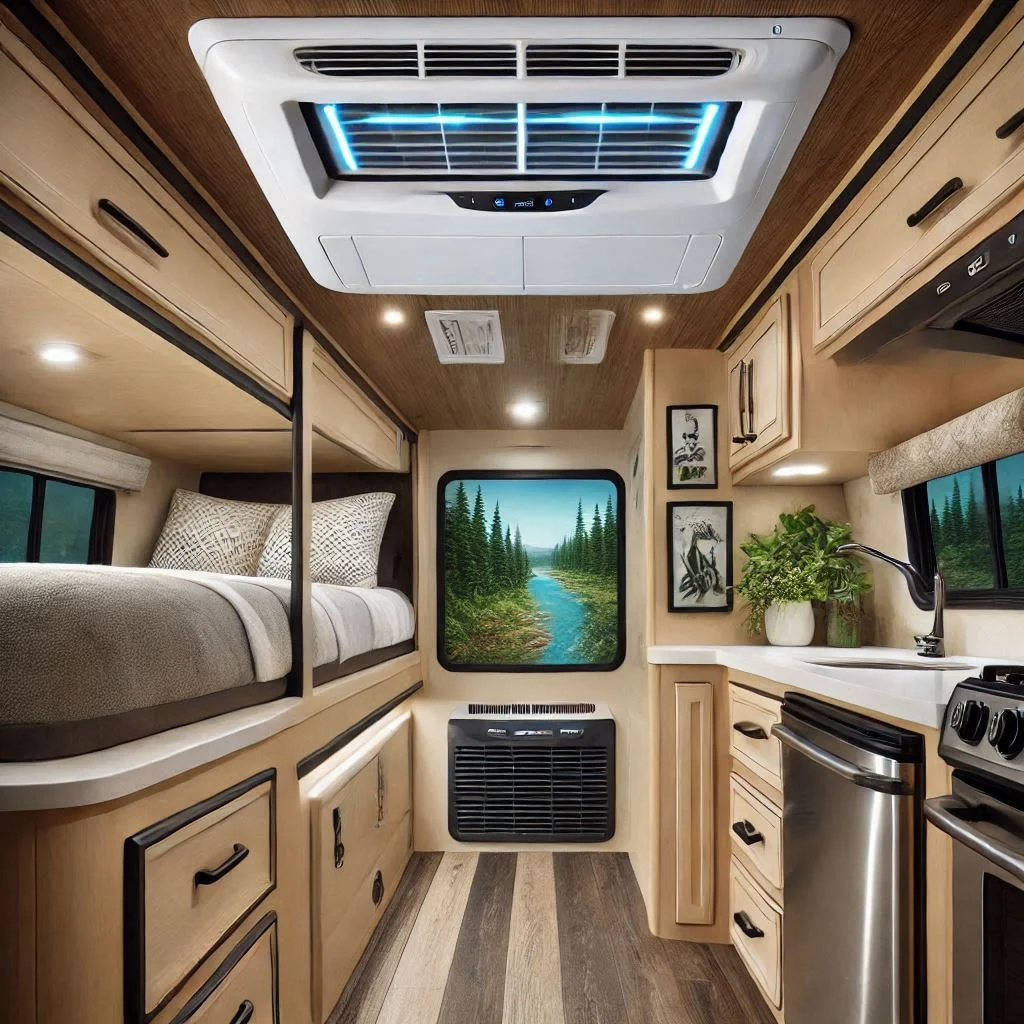
Split System RV AC Units
Split system air conditioners are an excellent choice for RV owners looking for a balance of performance and quiet operation. These units consist of two separate components: an indoor unit and an outdoor condenser. The indoor unit is mounted on the RV’s wall or ceiling, while the outdoor unit is placed outside, often near the rear of the RV. Split systems are highly effective at cooling large spaces and are quieter than rooftop units because the compressor is located outside.
Advantages of Split System RV AC Units:
- Quiet Operation: The external compressor reduces noise inside the RV, making it more comfortable.
- Effective Cooling: Offers superior cooling for larger RVs or when traveling in extreme heat.
- Flexibility: Can be installed in various locations inside the RV, allowing customization based on space and aesthetics.

By understanding the different types of RV air conditioners, RV owners can select the option that best meets their cooling needs. Whether you’re looking for a space-saving solution, superior cooling, or a quiet operation, there is an RV air conditioner that suits every requirement.
Key Takeaways:
- Rooftop units are best for larger RVs with limited interior space.
- Under-bench units are ideal for small RVs where space and quiet operation are crucial.
- Split systems offer a great balance of quiet performance and powerful cooling for large RVs.
Factors to Consider When Choosing the Best RV Air Conditioner
Choosing the best RV air conditioner goes beyond simply picking a brand or model. Several factors need to be considered to ensure the unit fits your RV size, provides efficient cooling, and operates quietly. Here’s a breakdown of the most important factors to consider when selecting the right air conditioner for your RV:
Cooling Capacity and RV Size
The cooling capacity of an RV air conditioner is measured in BTUs (British Thermal Units), and it determines how much cooling power the unit has. When choosing the best RV air conditioner, the cooling capacity should align with the size of your RV to ensure it efficiently cools the interior. If the cooling capacity is too low for your RV size, the AC will struggle to keep the temperature down. If it’s too high, it may consume unnecessary power.
How to Choose the Right Cooling Capacity for Your RV:
- For a small RV (under 100 sq. ft.), a 5,000 to 8,000 BTU unit should suffice.
- For a medium RV (100–200 sq. ft.), opt for a 9,000 to 13,000 BTU unit.
- For a large RV (over 200 sq. ft.), a 15,000 BTU or higher capacity air conditioner is recommended.
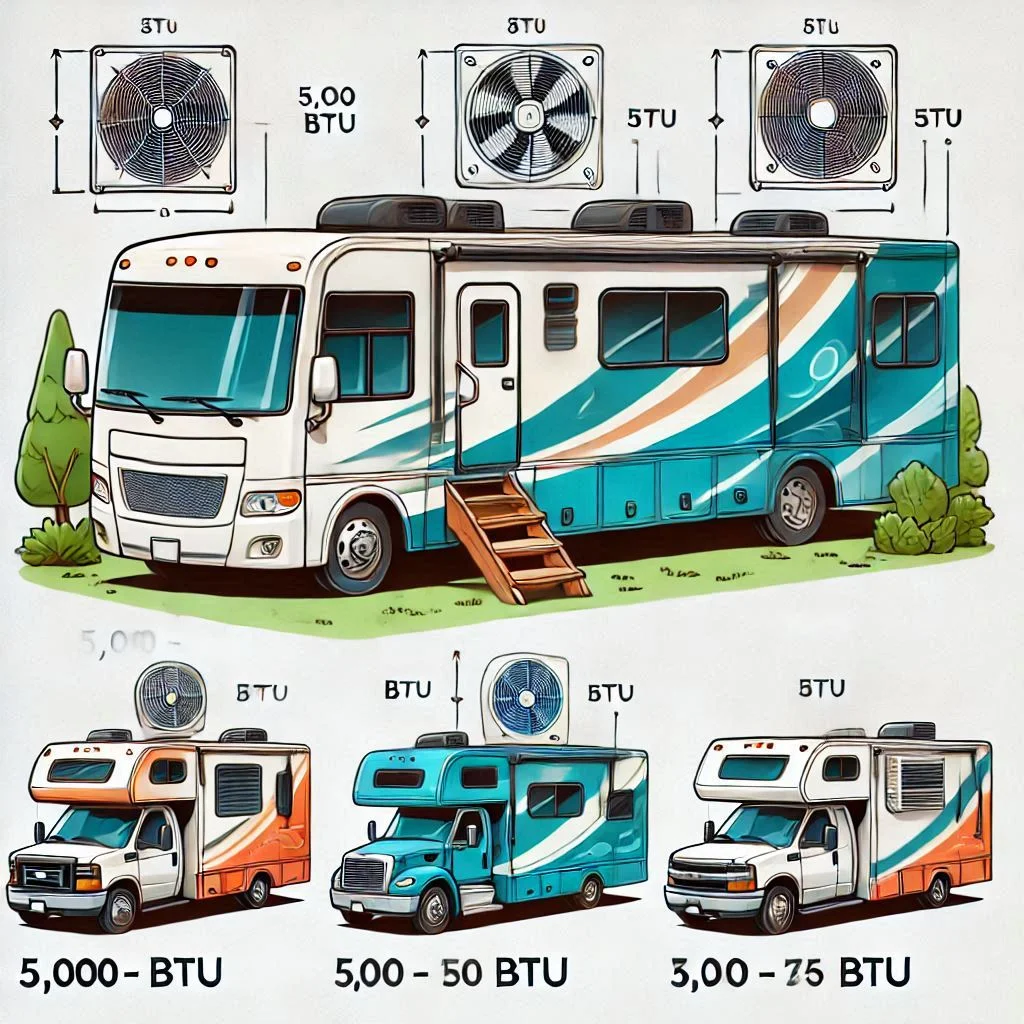
Energy Efficiency and Power Consumption
Energy efficiency is a critical factor in selecting the best RV air conditioner. Efficient units can save you money on energy bills and extend the life of your air conditioner. In addition, many RVs rely on limited power sources, such as solar panels or generator power, so choosing an energy-efficient model can reduce the strain on your electrical system.
Look for the following when considering energy efficiency:
- Energy Star certification: This indicates that the unit meets high efficiency standards and consumes less energy while maintaining effective cooling.
- Variable speed compressors: These adjust the cooling power based on demand, offering better energy efficiency.
- Low Power Draw: Some models feature low-power start-up technology, which is perfect for RV owners with limited electrical resources.

Noise Level and Comfort
Noise can be a significant factor when choosing an RV air conditioner. RVs are often used in environments where peace and quiet are essential for a restful experience. A noisy air conditioner can disrupt your comfort, especially during sleep.
Key considerations for noise levels:
- Sound Rating (dB): Air conditioners are typically rated between 50 and 80 dB. For the best comfort, look for units with a sound rating below 65 dB.
- Indoor vs. Outdoor Noise: Rooftop units can be noisy inside the RV, while split systems tend to keep the noise outside. Under-bench ACs are generally quieter but offer less cooling power.
- Noise Dampening Features: Some units feature noise-reducing technology or insulation to minimize operational sounds.

Key Takeaways:
- Cooling Capacity should be matched to your RV’s size for effective cooling.
- Energy Efficiency reduces power consumption, making it a must-have for off-grid RVing.
- Noise Levels affect comfort, so opt for quieter models when possible.
Choosing the best RV air conditioner means carefully balancing these factors to find the ideal unit for your needs. Whether you’re camping in the desert heat or traveling through the woods, the right AC can make your RV experience much more comfortable.
Installation and Maintenance of RV Air Conditioners
Proper installation and regular maintenance are essential for ensuring your RV air conditioner operates efficiently, prolongs its lifespan, and provides reliable cooling during your trips. Neglecting installation and maintenance can lead to decreased performance, higher energy consumption, and costly repairs. Here’s a detailed look at the importance of these factors and how to ensure your RV air conditioner is always in top shape.
Proper Installation
Proper installation is crucial for maximizing the effectiveness and longevity of your RV air conditioner. Whether you’re installing a rooftop, under-bench, or split system air conditioner, following manufacturer guidelines and ensuring correct placement are key to achieving optimal performance. Here’s what you need to know about proper installation:
Key Steps for Proper Installation:
- Location Selection:
Choose the ideal location for the unit, ensuring that the air intake and exhaust vents are not obstructed. For rooftop units, make sure the roof is structurally sound to support the AC. For under-bench or split systems, choose spaces that allow airflow without restricting cooling performance. - Electrical Considerations:
Ensure the electrical system is properly connected to handle the unit’s power needs. This includes checking the voltage requirements and ensuring the RV’s circuit can handle the load. Always use a qualified professional if you’re unsure about electrical connections. - Sealing and Insulation:
Proper sealing around the air conditioner helps prevent air leaks that can reduce efficiency. Use high-quality weatherproofing materials to seal the edges of the AC unit, and insulate areas around the unit to reduce heat gain or loss. - Test the Unit:
Once installed, test the unit to ensure it cools effectively. Verify that there are no unusual noises or vibrations, and check that the cooling performance is optimal for your RV size.
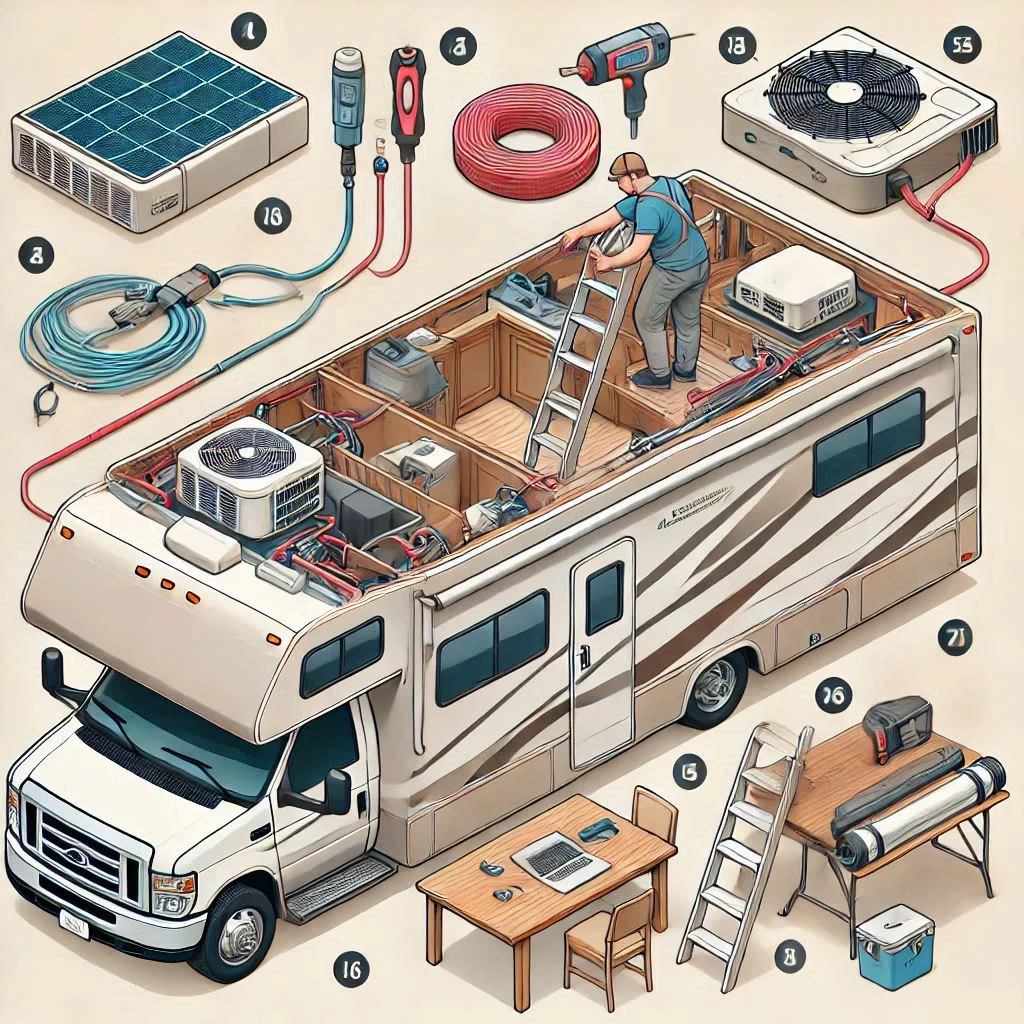
Regular Maintenance
Regular maintenance is vital for keeping your RV air conditioner running efficiently and avoiding unexpected breakdowns. Proper maintenance can also extend the life of your unit and ensure that it continues to provide the cooling comfort you need.
Essential RV Air Conditioner Maintenance Tasks:
- Cleaning the Air Filter:
The air filter should be cleaned or replaced regularly to ensure that the air conditioner runs smoothly. A clogged filter can cause poor airflow, which reduces efficiency and forces the unit to work harder, increasing energy consumption. - Checking the Coils:
Both the evaporator and condenser coils should be inspected periodically. If dirt or debris accumulates on the coils, it can hinder cooling performance. Clean the coils with a soft brush or air blower to remove any buildup. - Inspecting Ducts and Vents:
Ensure that all air ducts and vents are clear of obstructions. This allows proper airflow and ensures that cool air circulates throughout the RV. Any blockages can reduce cooling efficiency and increase the workload on the air conditioner. - Cleaning the Condensate Drain:
The condensate drain helps remove moisture from the system. If the drain becomes clogged, it can cause water buildup, leading to leaks or water damage. Regularly check and clean the drain to ensure proper functioning. - Lubricating Moving Parts:
Many RV air conditioners have moving parts, such as fans and motors. Regular lubrication of these parts helps prevent wear and tear and keeps the unit running smoothly. - Professional Inspection:
Once a year, consider having your RV air conditioner professionally inspected. A technician can spot potential issues early and perform any necessary repairs to ensure your unit remains in peak condition.
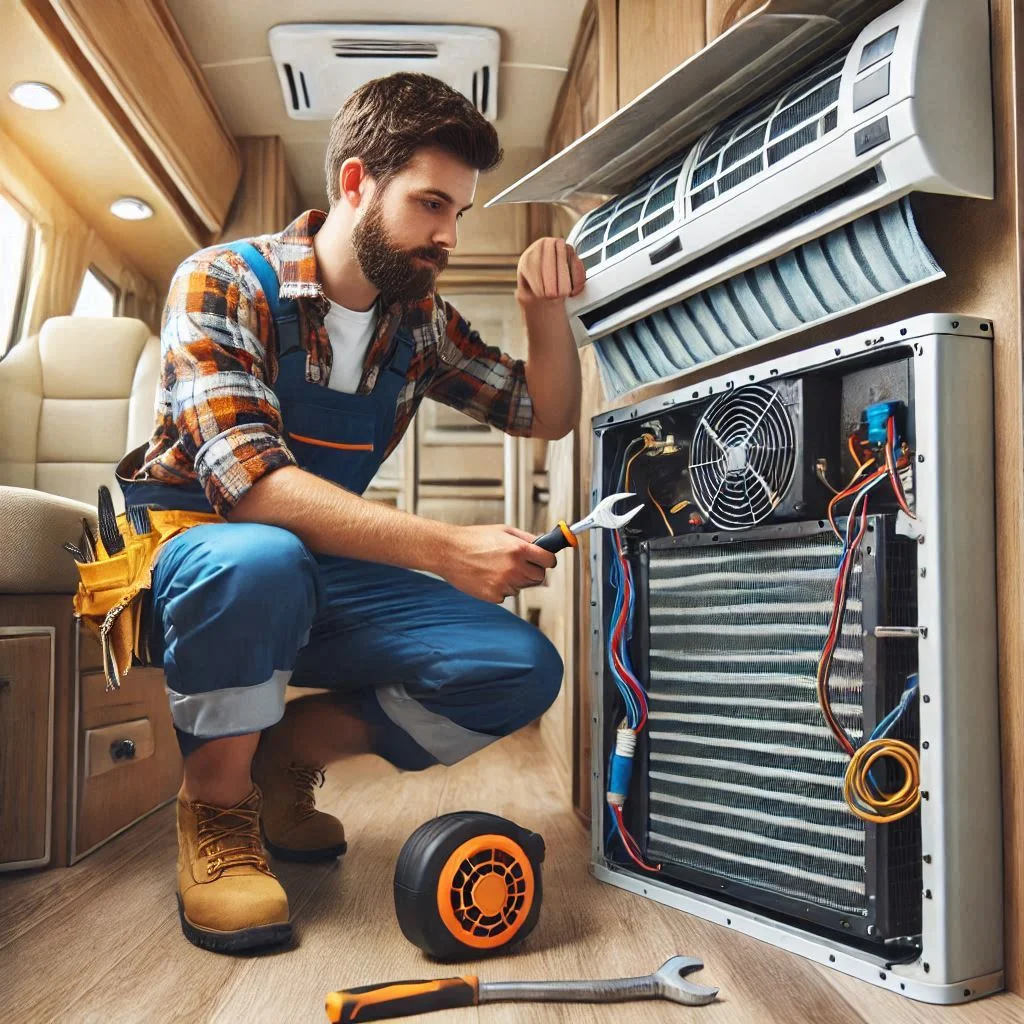
Key Takeaways:
- Proper Installation: Ensure correct placement, electrical setup, and sealing to avoid inefficiencies and breakdowns.
- Regular Maintenance: Clean filters, check coils, inspect ducts, and perform professional inspections to keep your RV air conditioner running optimally.
By following these installation and maintenance steps, you can enjoy a fully functional and efficient air conditioning system throughout your RV journeys. Regular care ensures that your unit remains in top condition and extends its lifespan, providing you with many comfortable trips.
Top RV Air Conditioner Brands and Models
When selecting the best RV air conditioner, choosing a reputable brand ensures that you are investing in quality, durability, and reliability. Some of the most trusted brands in the RV air conditioner industry are Dometic, Coleman, and Pioneer. In this guide, we’ll explore the top models from these brands, helping you choose the right unit for your RV.
Dometic RV Air Conditioners
Dometic is one of the most recognized names in the RV industry, known for producing reliable, high-quality air conditioners that offer excellent cooling performance. They offer a range of models suited for different RV sizes and cooling needs.
Top Dometic RV Air Conditioner Models:
- Dometic Brisk II Evolution 13.5K BTU
The Dometic Brisk II Evolution is a top choice for RV owners looking for powerful cooling performance. With a 13,500 BTU capacity, it provides ample cooling for medium to large RVs. Its high-efficiency compressor and robust build make it an excellent choice for long-lasting performance. - Dometic Penguin II High Capacity with Heat Pump
The Penguin II is designed for those who need both cooling and heating. This model comes with a heat pump for year-round comfort, making it a versatile option for various climates. It also offers a quiet operation and an energy-efficient design. - Dometic Blizzard NXT 15K
The Dometic Blizzard NXT is perfect for larger RVs that require superior cooling power. With a 15,000 BTU capacity, it’s one of the most powerful models in Dometic’s lineup. It also boasts modern features like low power consumption and an aerodynamic design.
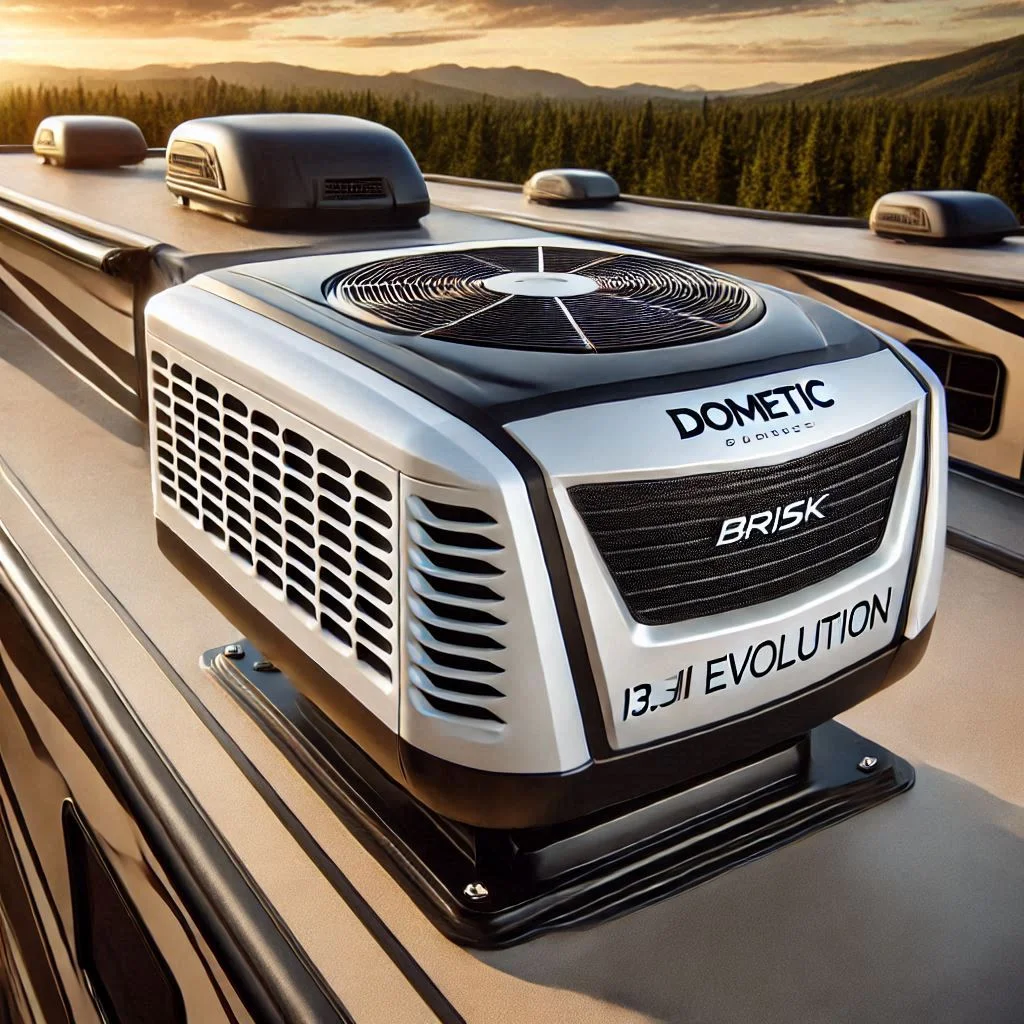
Coleman RV Air Conditioners
Coleman is another trusted brand in the RV air conditioner market, offering models known for their affordability, efficiency, and ease of installation. Coleman air conditioners are built to handle various climates, providing dependable cooling in even the most challenging conditions.
Top Coleman RV Air Conditioner Models:
- Coleman Mach 15+
The Mach 15+ is one of Coleman’s most popular models, offering 15,000 BTUs of cooling power. It’s designed for larger RVs and features a high-efficiency motor that reduces power consumption without sacrificing cooling performance. Its robust construction ensures durability and longevity. - Coleman Mach 3 Plus
The Mach 3 Plus is a great option for medium-sized RVs. It provides 13,500 BTUs of cooling and is known for its quiet operation. With its simple installation and reliable performance, it’s ideal for RV owners looking for a straightforward, budget-friendly cooling solution. - Coleman Polar Cub 8
For smaller RVs, the Polar Cub 8 is an excellent choice. With 8,000 BTUs of cooling power, it offers efficient performance without drawing excessive power. Its compact size makes it easy to install and perfect for tight spaces.
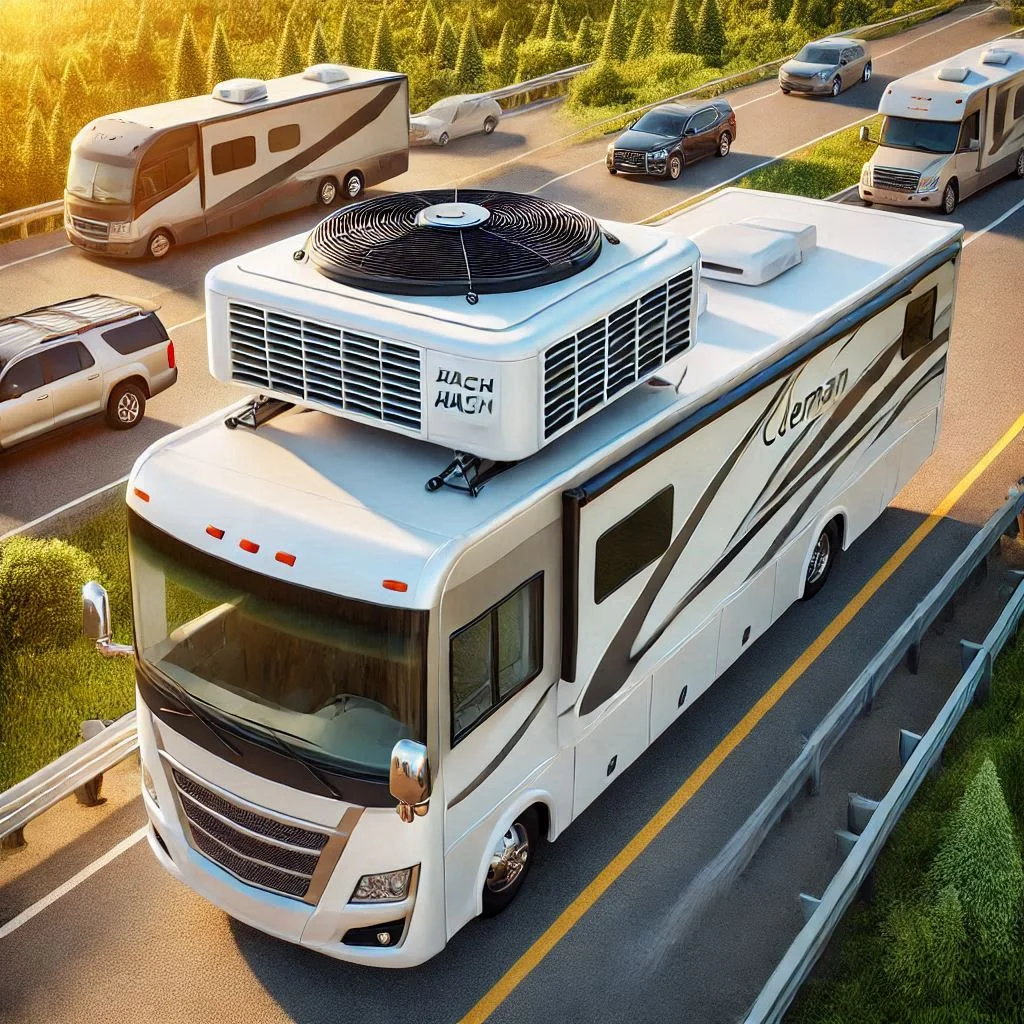
Pioneer RV Air Conditioners
Pioneer is a newer brand in the RV air conditioner market, but it has quickly gained recognition for its advanced technology and efficiency. Pioneer units are known for their energy-saving features and ability to provide reliable cooling even in high-temperature environments.
Top Pioneer RV Air Conditioner Models:
- Pioneer Mini-Split AC System
The Pioneer Mini-Split AC System is an innovative choice for RV owners. Unlike traditional rooftop units, the mini-split system has an outdoor condenser unit and an indoor air handler, making it more energy-efficient and quieter. It provides exceptional cooling for medium to large RVs and is ideal for off-grid camping. - Pioneer 12,000 BTU Ductless Mini-Split
The Pioneer 12,000 BTU Ductless Mini-Split is perfect for those looking for a quiet, powerful, and efficient system. This unit is particularly great for RVs with limited roof space, as it requires no rooftop installation. It offers cooling and heating options, making it versatile for all seasons. - Pioneer 18,000 BTU Ductless Mini-Split
For larger RVs, the Pioneer 18,000 BTU Ductless Mini-Split offers the power and efficiency needed to cool the interior quickly. It’s a quiet, energy-efficient solution that’s ideal for full-time RV living or extended trips in hot climates.
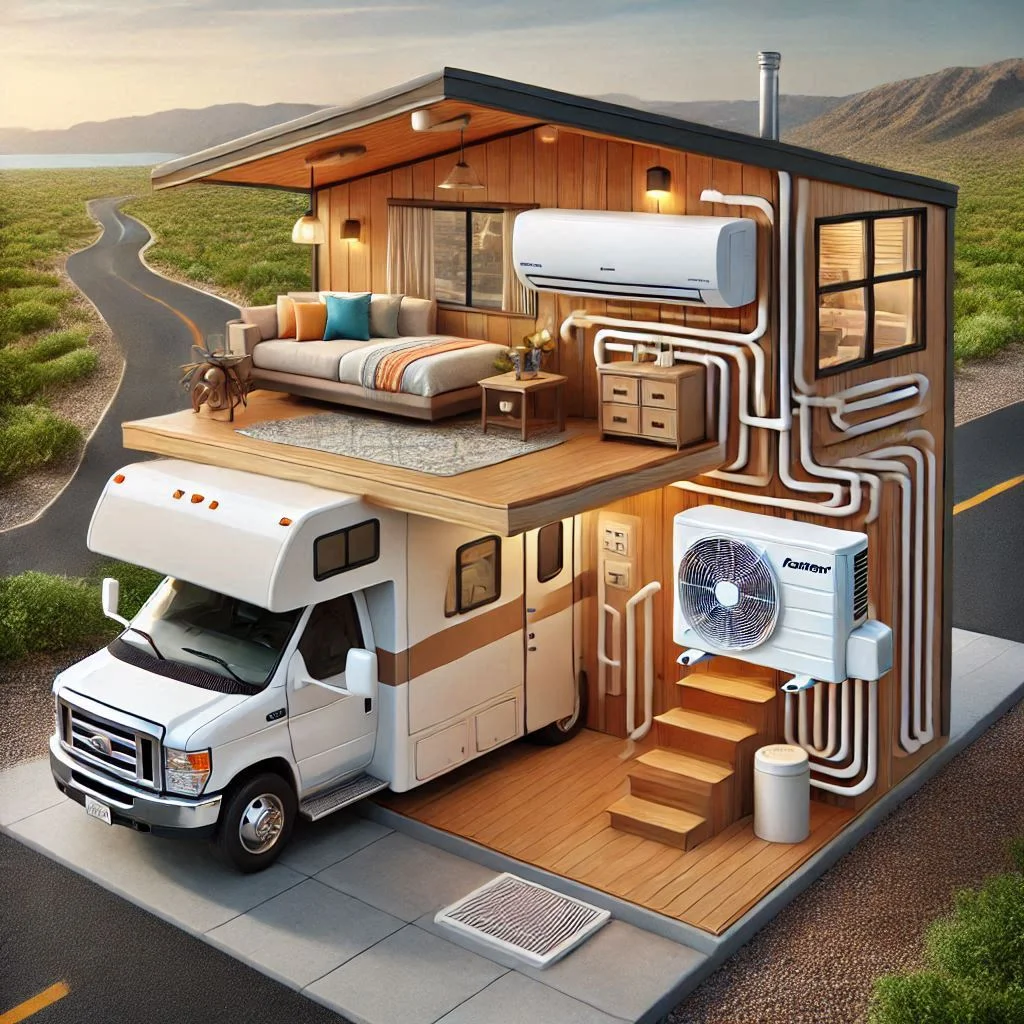
Key Takeaways:
- Dometic: Known for powerful units with excellent cooling capacity, perfect for larger RVs and year-round use.
- Coleman: Offers reliable, budget-friendly air conditioners with good efficiency, ideal for medium-sized to large RVs.
- Pioneer: Innovative and energy-efficient, perfect for those seeking quiet, powerful cooling, especially in off-grid or space-limited setups.
Best Portable AC Units for RVs
When it comes to cooling your RV, a portable air conditioner can be a convenient and effective solution, especially if you don’t want to deal with the hassle of installing a permanent AC unit. Whether you’re camping, road-tripping, or simply staying in your RV for extended periods, these top portable AC models can keep you cool during the heat of summer.
In this guide, we’ll explore the best portable air conditioners for RVs, highlighting their features, performance, and overall suitability for RV living.
1. Whynter Elite ARC-122DS
The Whynter Elite ARC-122DS is one of the most efficient portable AC units on the market, offering a powerful 12,000 BTU cooling capacity. This model is perfect for RVs with limited space and offers a 3-in-1 cooling, dehumidifying, and fan function, making it versatile for all your climate control needs.
Key Features:
- Dual Hose System: This unit uses a dual hose system, which is more efficient than a single hose, reducing energy consumption while improving cooling speed.
- Dehumidifier Function: This portable AC also doubles as a dehumidifier, removing moisture from the air, which is especially useful in humid climates.
- Eco-Friendly Refrigerant: It uses R-32 refrigerant, which is both energy-efficient and eco-friendly.
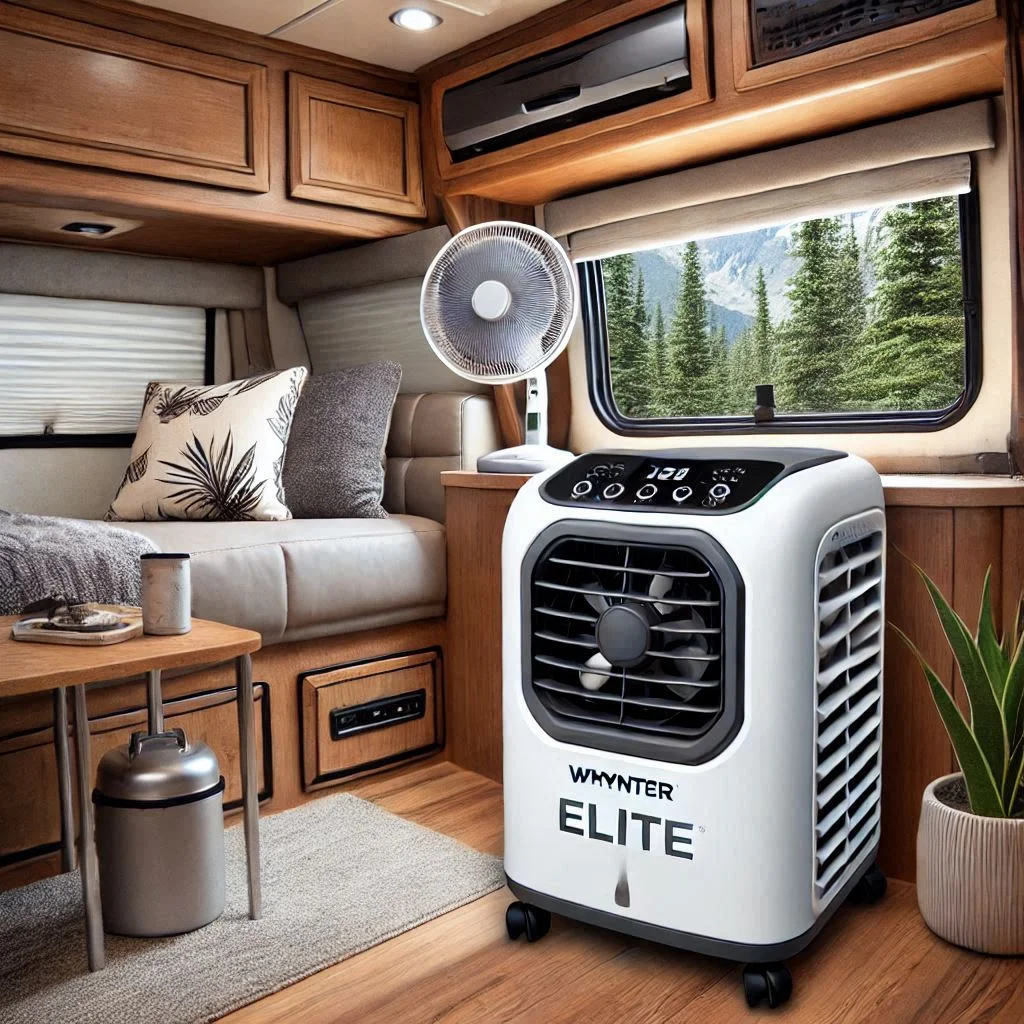
2. LG LP0621WSR
The LG LP0621WSR is a reliable, budget-friendly portable AC unit designed for smaller RVs or specific areas within your RV. With a 6,000 BTU cooling capacity, it’s ideal for cooling smaller spaces, such as bedrooms or living areas.
Key Features:
- Compact Design: Perfect for tight spaces, its slim and sleek design won’t take up much room.
- Easy Installation: The unit comes with an easy-to-install window venting kit, making it hassle-free to set up.
- Quiet Operation: Despite its smaller size, this unit operates quietly, providing a peaceful environment while you relax in your RV.
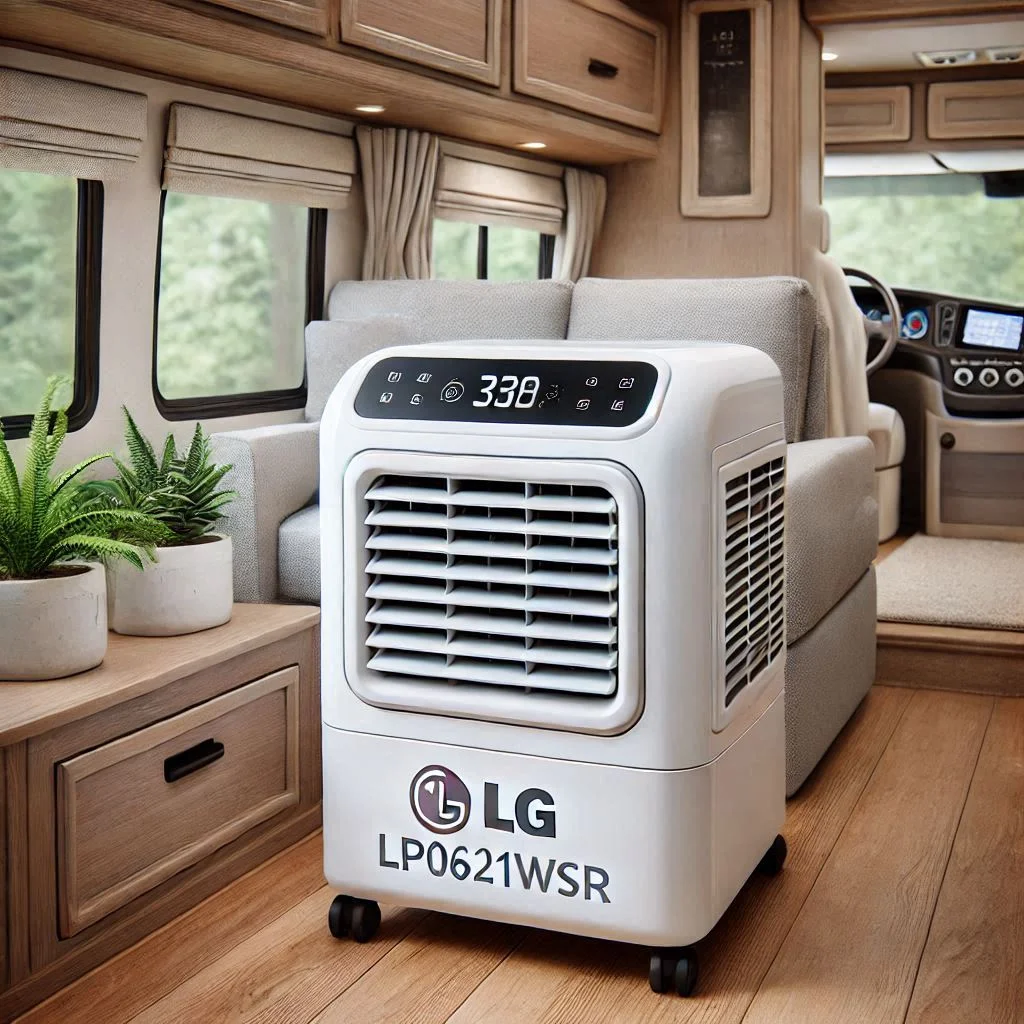
3. Whynter ARC-14S
The Whynter ARC-14S is a high-performance portable air conditioner with a 14,000 BTU capacity, ideal for larger RVs or if you need more powerful cooling. This model is highly rated for its cooling efficiency and ease of use.
Key Features:
- Dual Hose Operation: Just like the Whynter Elite, the ARC-14S uses dual hoses to increase cooling efficiency and reduce energy usage.
- Auto Restart Feature: This feature ensures that the unit resumes operation automatically in the event of a power outage.
- Dehumidifier: It also functions as a dehumidifier, which is perfect for humid environments.
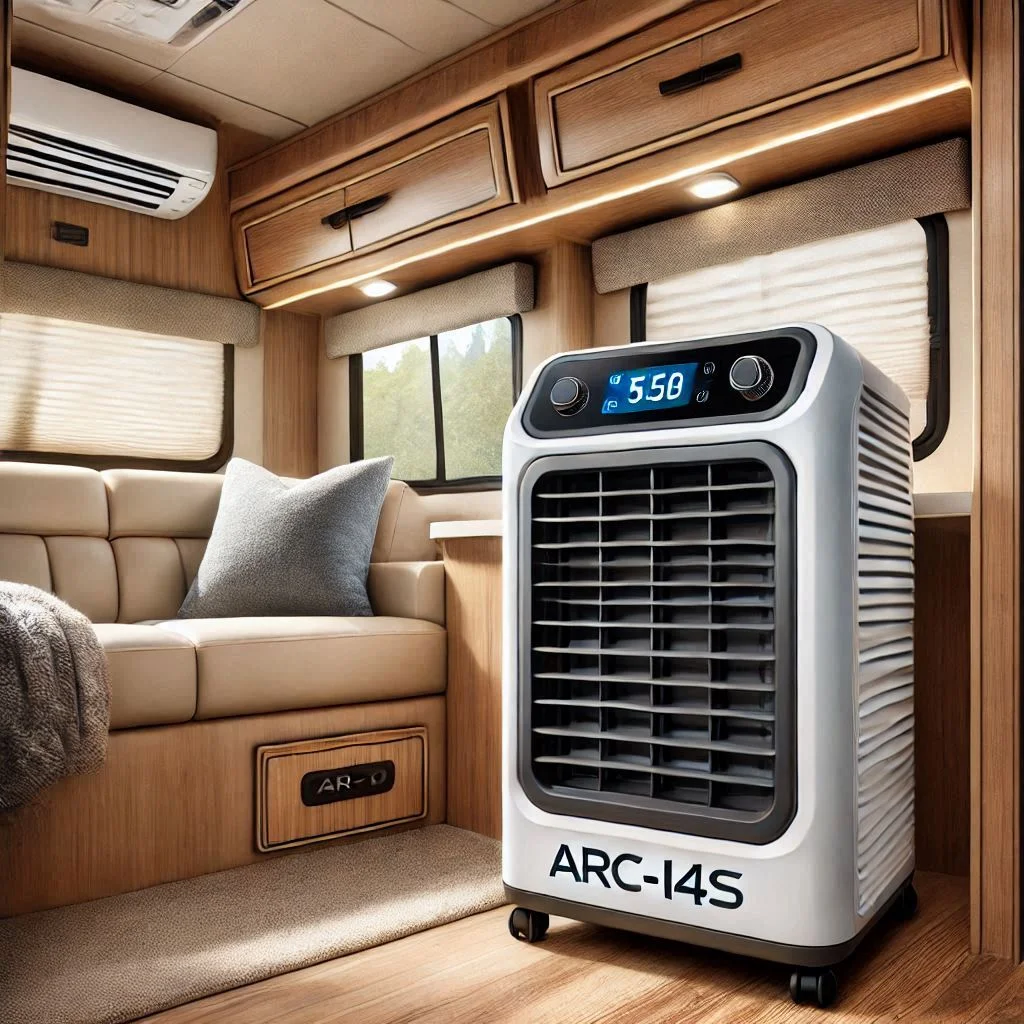
4. Homelabs Portable Air Conditioner
The Homelabs Portable Air Conditioner is an affordable, easy-to-use option for RV owners who need basic cooling functionality. It provides 8,000 BTUs of cooling power, which is sufficient for smaller to medium-sized RVs.
Key Features:
- User-Friendly Controls: It comes with an intuitive control panel, making it easy to operate.
- Efficient Energy Use: It is an energy-efficient model, which helps reduce your power consumption when running the AC for long hours.
- Portable Design: With rolling wheels, it’s easy to move from one area to another inside your RV.
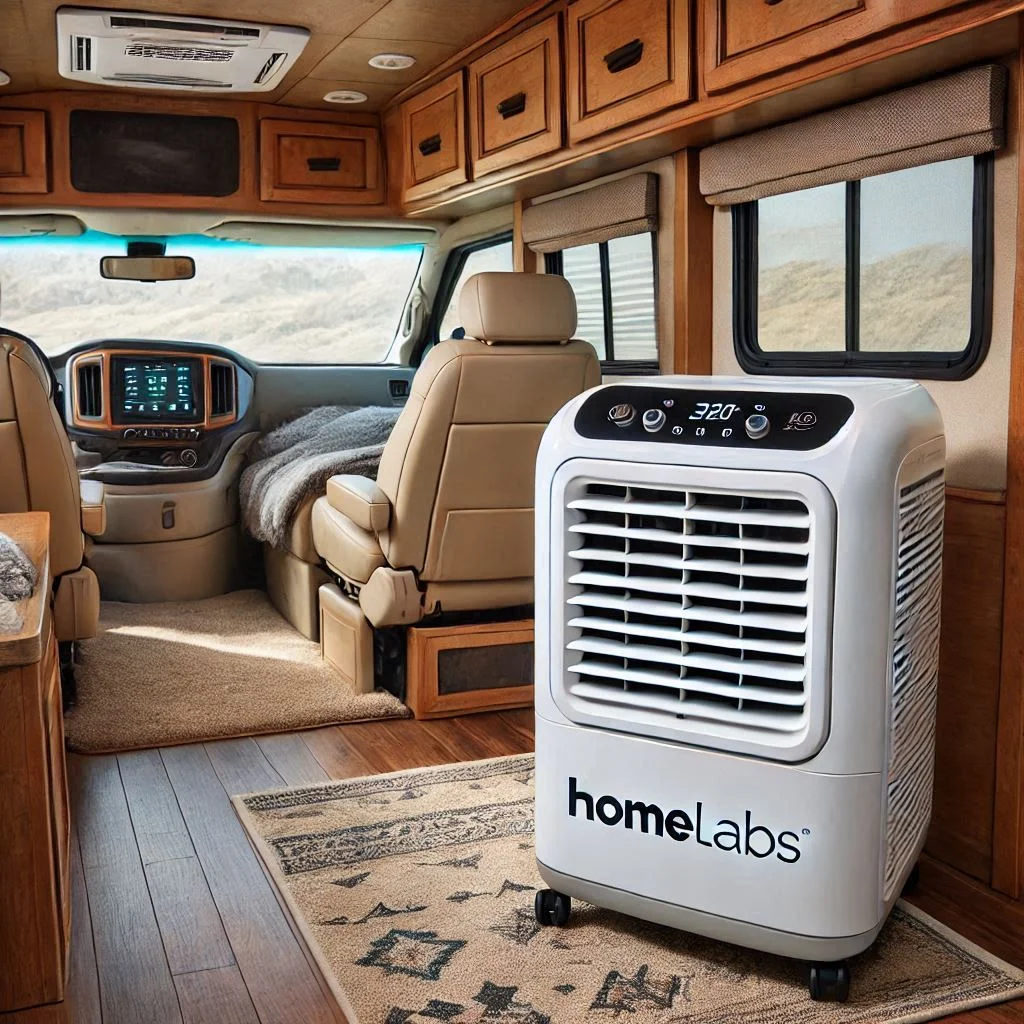
5. De’Longhi Pinguino PACEX390LVYN
The De’Longhi Pinguino PACEX390LVYN is a premium portable AC unit that offers powerful cooling and an eco-friendly design. With a 13,500 BTU capacity, this unit is perfect for larger RVs or for those seeking more efficient cooling.
Key Features:
- Quiet Operation: The Pinguino is designed to run quietly, providing comfortable cooling without excessive noise.
- Eco-Friendly Refrigerant: It uses R-32 refrigerant, which is better for the environment compared to traditional refrigerants.
- Portable and Stylish: It features a compact, modern design that blends seamlessly into your RV’s interior.
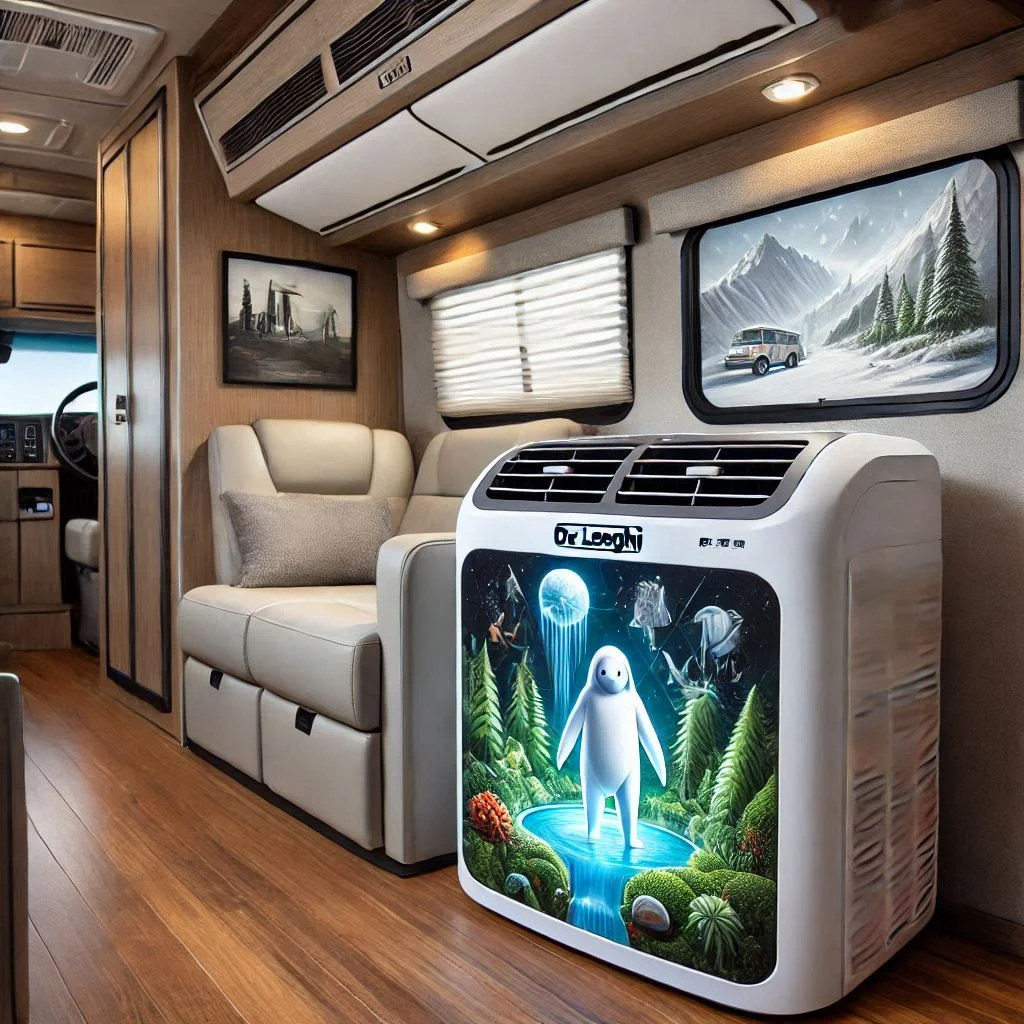
6. Frigidaire FHPC082AC1
The Frigidaire FHPC082AC1 is a well-rounded portable air conditioner that combines cooling with dehumidifying functions. With 8,000 BTUs of cooling power, it’s perfect for smaller to medium-sized RVs.
Key Features:
- Multi-Function Operation: It works as an air conditioner, dehumidifier, and fan, providing versatility for different climates.
- Easy to Use: Features an easy-to-operate remote control and simple installation process.
- Energy Efficient: Designed with energy-saving features to help minimize electricity use.
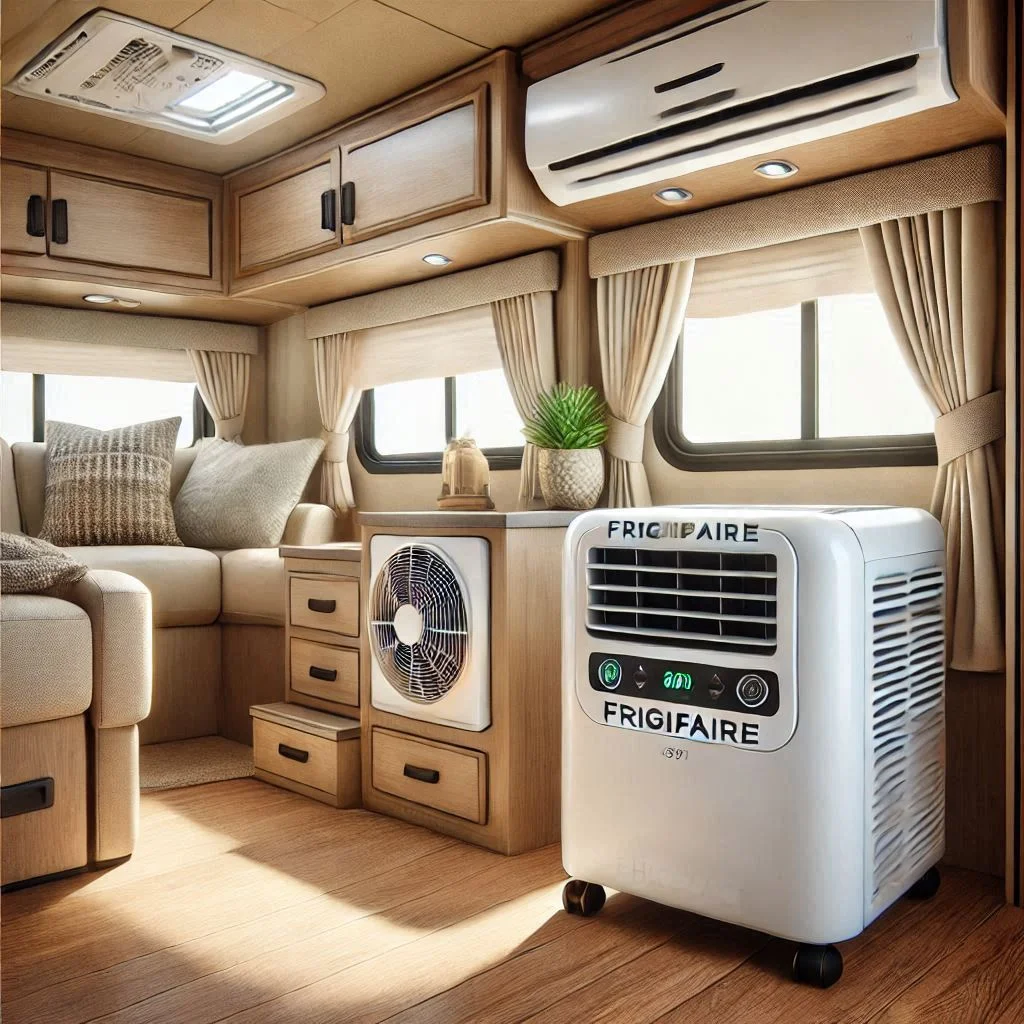
7. Midea MAP08R1CWT
The Midea MAP08R1CWT is a budget-friendly portable air conditioner that delivers reliable cooling for RV owners on a budget. With an 8,000 BTU cooling capacity, it’s an ideal choice for smaller RVs or as a supplementary cooling unit.
Key Features:
- Compact Design: Small and lightweight, it won’t take up much space in your RV.
- Energy Efficient: This model is designed to provide cooling while minimizing power consumption.
- User-Friendly Controls: The simple digital controls make it easy to adjust settings.
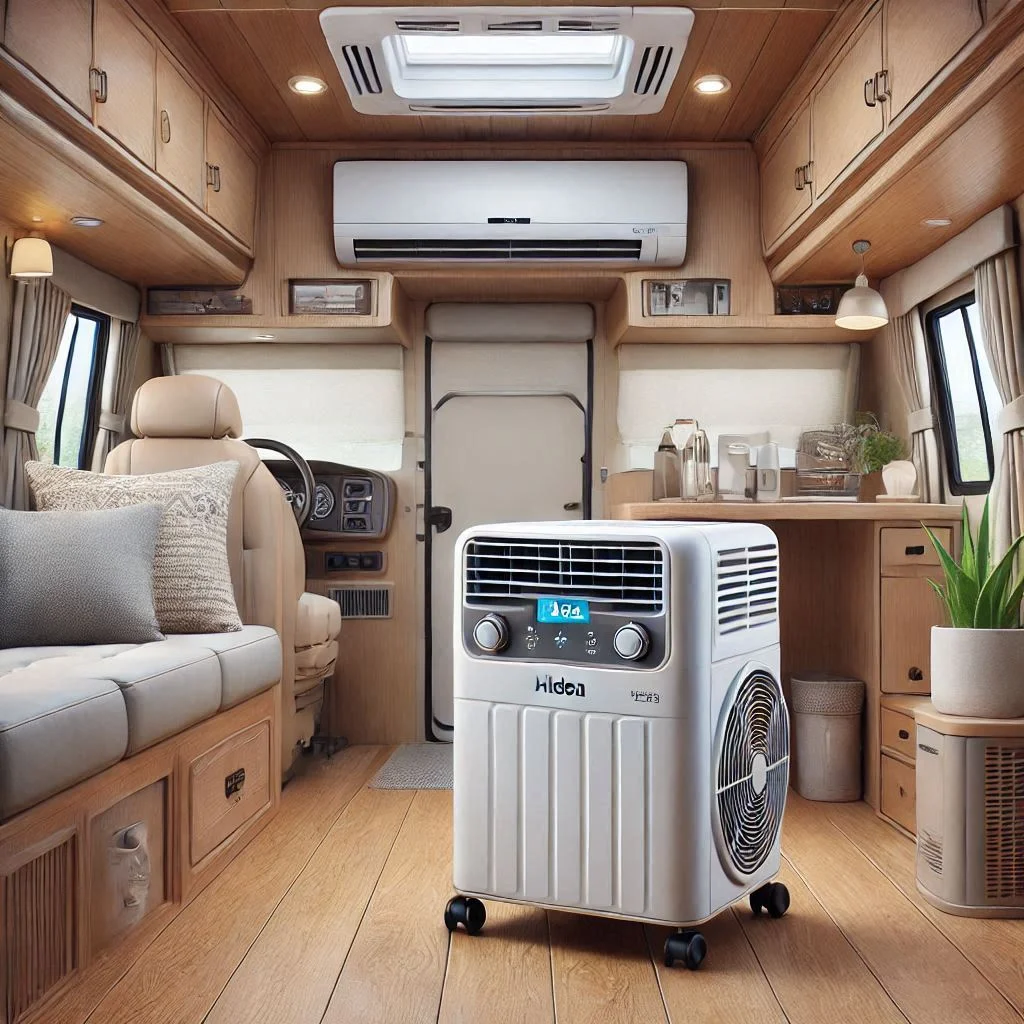
Key Takeaways:
- Best for Larger RVs: The Whynter ARC-14S and De’Longhi Pinguino PACEX390LVYN offer powerful cooling capacities (14,000-15,000 BTUs), ideal for larger RVs.
- Best Budget Options: The LG LP0621WSR and Midea MAP08R1CWT provide affordable and efficient cooling for smaller spaces.
- Versatility: Many of these units combine air conditioning with dehumidifying functions, making them perfect for humid climates.
How to Find the Best RV Air Conditioner for Your Needs
When it comes to choosing the best RV air conditioner, several important factors determine its efficiency, performance, and overall suitability for your RV. The right AC unit can provide you with a comfortable environment, especially during hot summer months. In this guide, we will break down the essential features to look for in the best RV air conditioner to help you make an informed decision.
Cooling Capacity
The cooling capacity of an RV air conditioner is one of the most crucial factors to consider. The cooling capacity, measured in BTUs (British Thermal Units), determines how well the air conditioner can cool your RV. To ensure you select the right air conditioner for your space, it’s important to match the BTU rating with the size of your RV.
- For smaller RVs (under 200 square feet): An air conditioner with a 6,000 to 8,000 BTU capacity will be sufficient.
- For medium-sized RVs (200-400 square feet): A 10,000 to 12,000 BTU unit is ideal.
- For larger RVs (over 400 square feet): Opt for an air conditioner with 14,000 to 15,000 BTUs.
Choosing the right cooling capacity ensures that the air conditioner runs efficiently and cools the entire space without overworking.
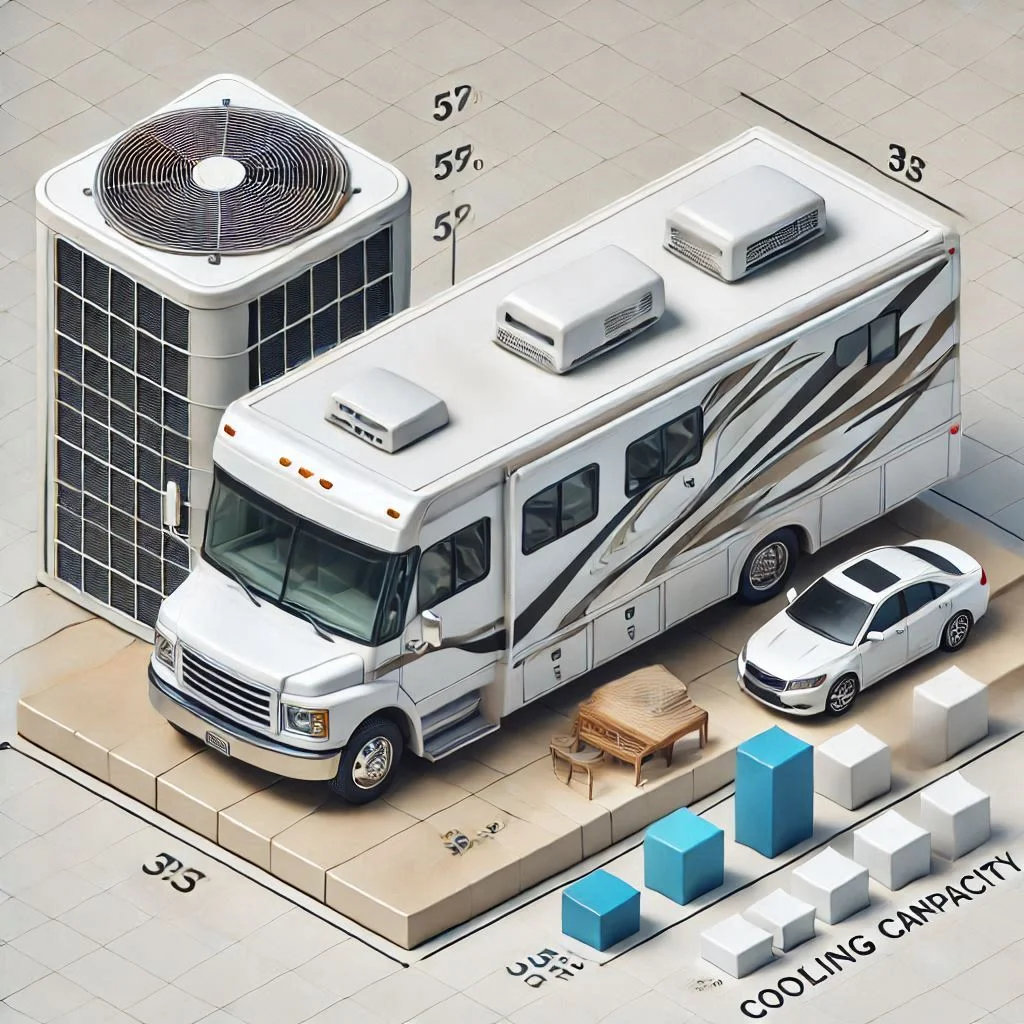
Noise Level
The noise level of your RV air conditioner is another important factor to consider. Since RVs are compact, excessive noise can disrupt your relaxation and disturb others within close quarters. Choose a model known for quiet operation to maintain a peaceful atmosphere in your RV.
- Decibel Range (dB): Air conditioners with a noise level below 60 dB are considered quiet and comfortable for RVs.
- Sound Dampening Technology: Some air conditioners come with special noise-reducing technology, which is an added bonus if you’re sensitive to noise.
The lower the decibel level, the quieter and more comfortable your air conditioner will be. Look for models that have sleep mode or eco mode, which further reduce noise while maintaining cooling performance.
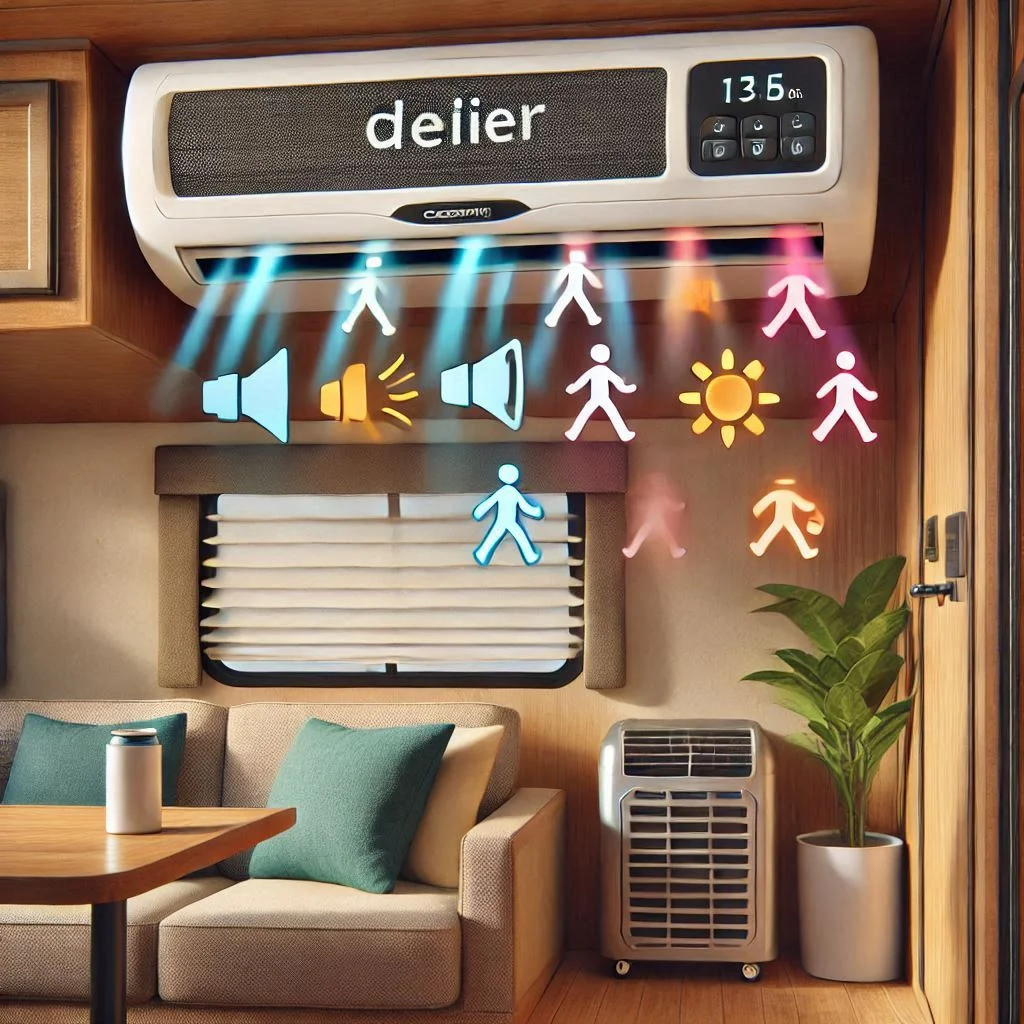
Energy Efficiency
Energy efficiency is a major consideration, especially if you plan on running the air conditioner for extended periods while off the grid. Opting for an energy-efficient model can save you a significant amount on electricity bills and reduce the environmental impact.
- Energy Star Rating: Look for units with the Energy Star label, as these are designed to consume less power without sacrificing performance.
- Inverter Technology: Units with inverter technology adjust the compressor speed based on the cooling demand, improving energy efficiency.
- Power Consumption: Check the unit’s power consumption in watts. Lower consumption means less energy use, which is ideal for RVs with limited power sources.
Selecting an energy-efficient air conditioner helps you stay cool without draining your RV’s battery or generating excessive heat.
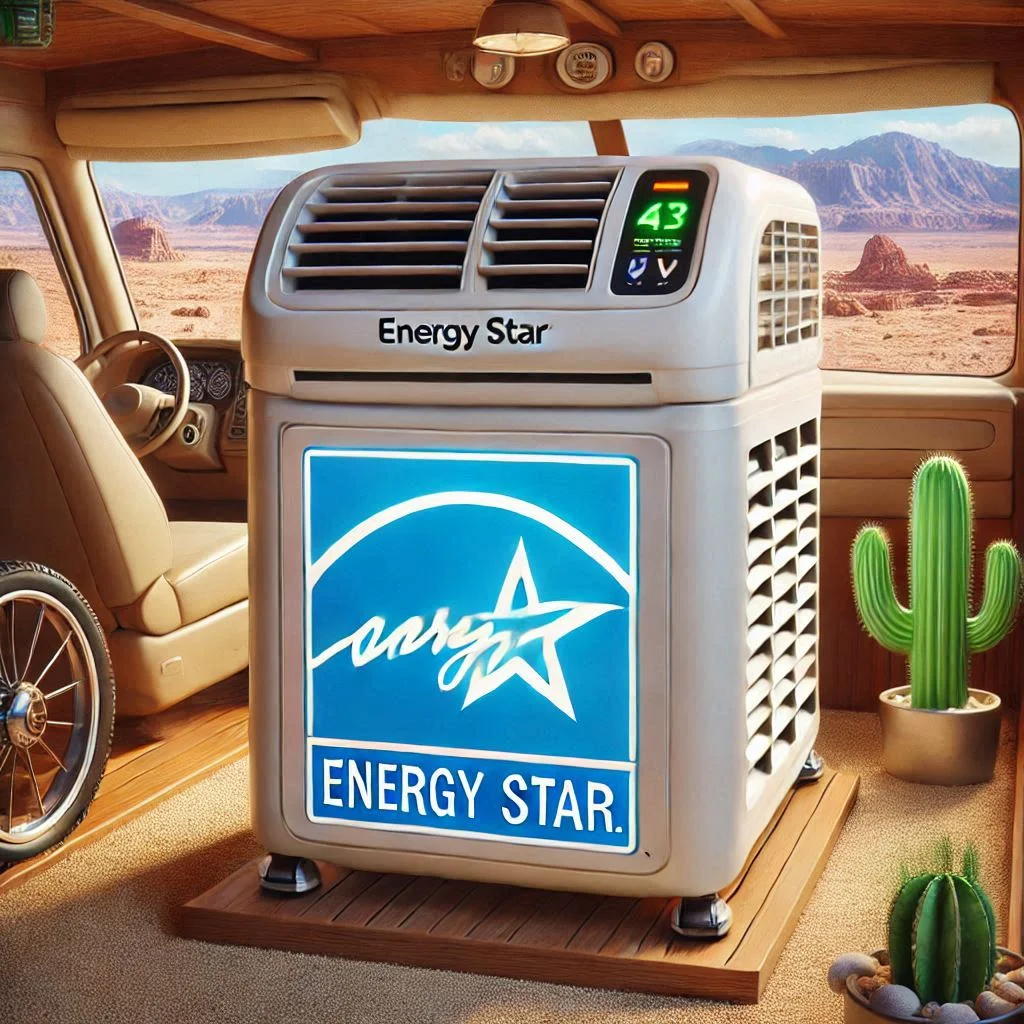
Additional Features
- Dehumidification Mode: Some models include a dehumidifier feature that removes excess moisture from the air, which is particularly beneficial in humid climates.
- Multi-Speed Fan: An air conditioner with multiple fan speeds allows you to adjust airflow based on your preferences, providing a more customized cooling experience.
- Auto-Restart: This feature ensures that the air conditioner automatically restarts after a power outage, saving you the hassle of manually resetting it.
- Remote Control and Smart Features: Many modern RV air conditioners offer remote control functionality, allowing you to adjust settings from anywhere inside your RV. Some even come with smart connectivity for app control.
These additional features add value to your purchase and can significantly improve your comfort while camping or living in your RV.

Key Takeaways:
- Cooling Capacity: Match the BTU rating with your RV size for optimal cooling performance.
- Noise Level: Opt for models with low decibel levels for a quieter and more comfortable environment.
- Energy Efficiency: Choose Energy Star-rated units with inverter technology to save energy and reduce costs.
- Additional Features: Consider extra functions like dehumidification, auto-restart, and remote control for a more convenient and customized cooling experience.
Frequently Asked Questions About RV Air Conditioners
Choosing the right RV air conditioner can be challenging, especially with so many options available. Below are some frequently asked questions (FAQs) to help guide your decision-making process. Each question has been answered with key details that highlight essential factors for finding the best RV air conditioner for your needs.
1. What is the best RV air conditioner for a small RV?
For smaller RVs (under 200 square feet), the best RV air conditioners are typically 6,000 to 8,000 BTUs. These models provide sufficient cooling power without overloading the electrical system in smaller RVs. Look for compact, efficient units that don’t take up too much space and operate quietly.
Some top models include:
- Dometic Brisk II (6,000-8,000 BTU)
- Coleman Mach 8 (8,000 BTU)
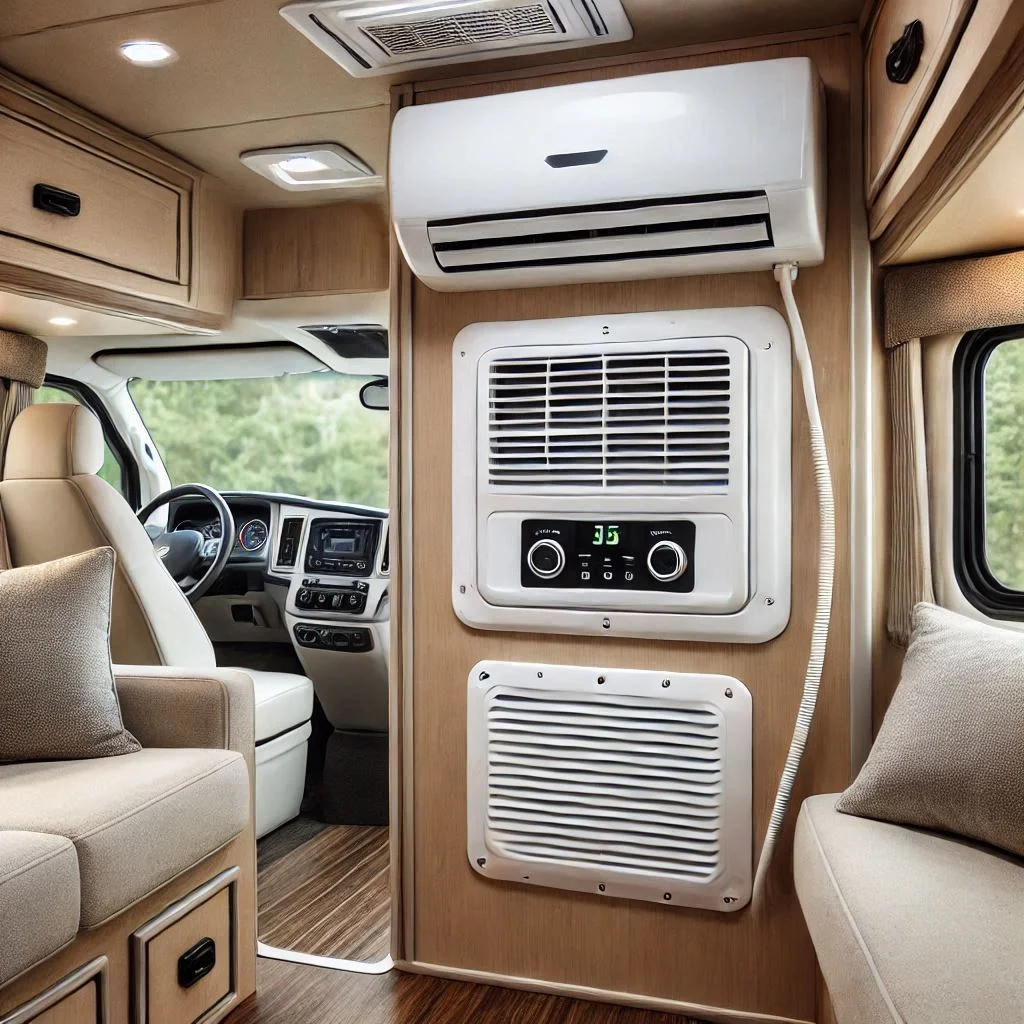
2. How do I calculate the right BTU for my RV air conditioner?
To calculate the right BTU (cooling capacity) for your RV air conditioner, consider the following factors:
- RV Size: A larger RV requires more cooling capacity.
- Insulation: Well-insulated RVs require less cooling power.
- Climate: Hotter climates require air conditioners with higher BTUs.
For a standard RV:
- Under 200 square feet: 6,000-8,000 BTU
- 200-400 square feet: 10,000-12,000 BTU
- 400+ square feet: 14,000-15,000 BTU
Always round up if you’re in a particularly hot or poorly insulated area to ensure you have enough cooling power.

3. What is the most energy-efficient RV air conditioner?
Energy efficiency is essential for reducing power consumption and ensuring long-term cost savings. Some of the most energy-efficient RV air conditioners feature inverter technology that adjusts compressor speed based on cooling demand.
Top models known for energy efficiency include:
- Dometic Brisk II Evolution with inverter technology
- Coleman Mach 8 for its low energy consumption
- Pioneer Mini-Split systems
Look for air conditioners with Energy Star certification for guaranteed efficiency and low energy consumption.
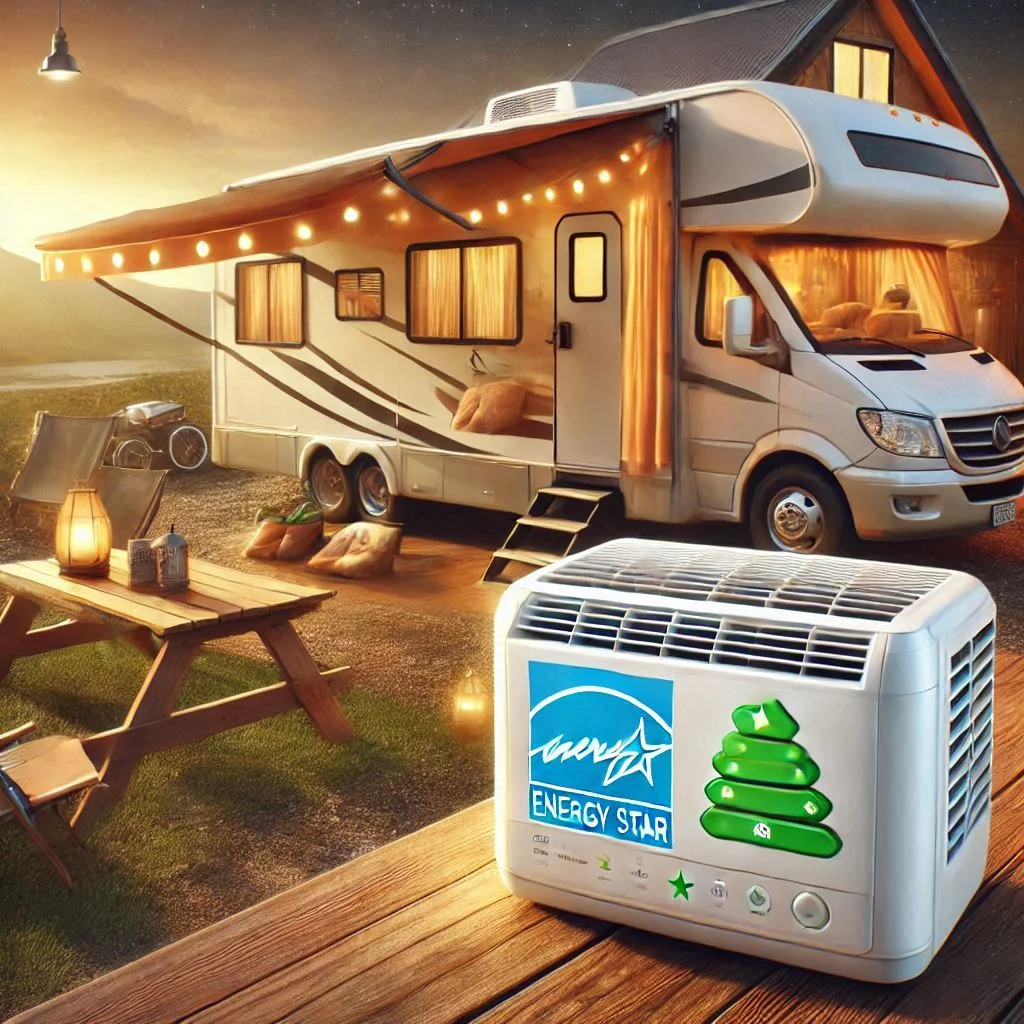
4. Are there RV air conditioners with low noise levels?
Yes, there are several models designed to operate quietly, ideal for users who prioritize peace and comfort inside their RV. Models with low dB levels and noise-reducing technology are perfect for reducing disruption while you sleep or relax.
Some quiet RV air conditioners include:
- Dometic Brisk II (Known for quiet operation)
- Coleman Mach 8 (Low noise levels for a more peaceful environment)
- Whynter Elite ARC-122DS portable AC (for noise-conscious users)
Aim for units with less than 60 dB to ensure a quiet, comfortable experience.

5. Can I install an RV air conditioner myself?
Yes, many RV air conditioners can be installed by DIY enthusiasts, but the process depends on the type of unit you choose. Rooftop air conditioners often require professional installation due to the complexity of mounting them and connecting them to the RV’s electrical system. However, portable and under-bench air conditioners are easier to install.
If you’re looking for DIY-friendly options:
- Under-Bench ACs are simple to install under a countertop or in a storage compartment.
- Portable ACs only require venting through a window or door.
For rooftop units, it’s always advisable to consult a professional for installation to avoid potential damage.
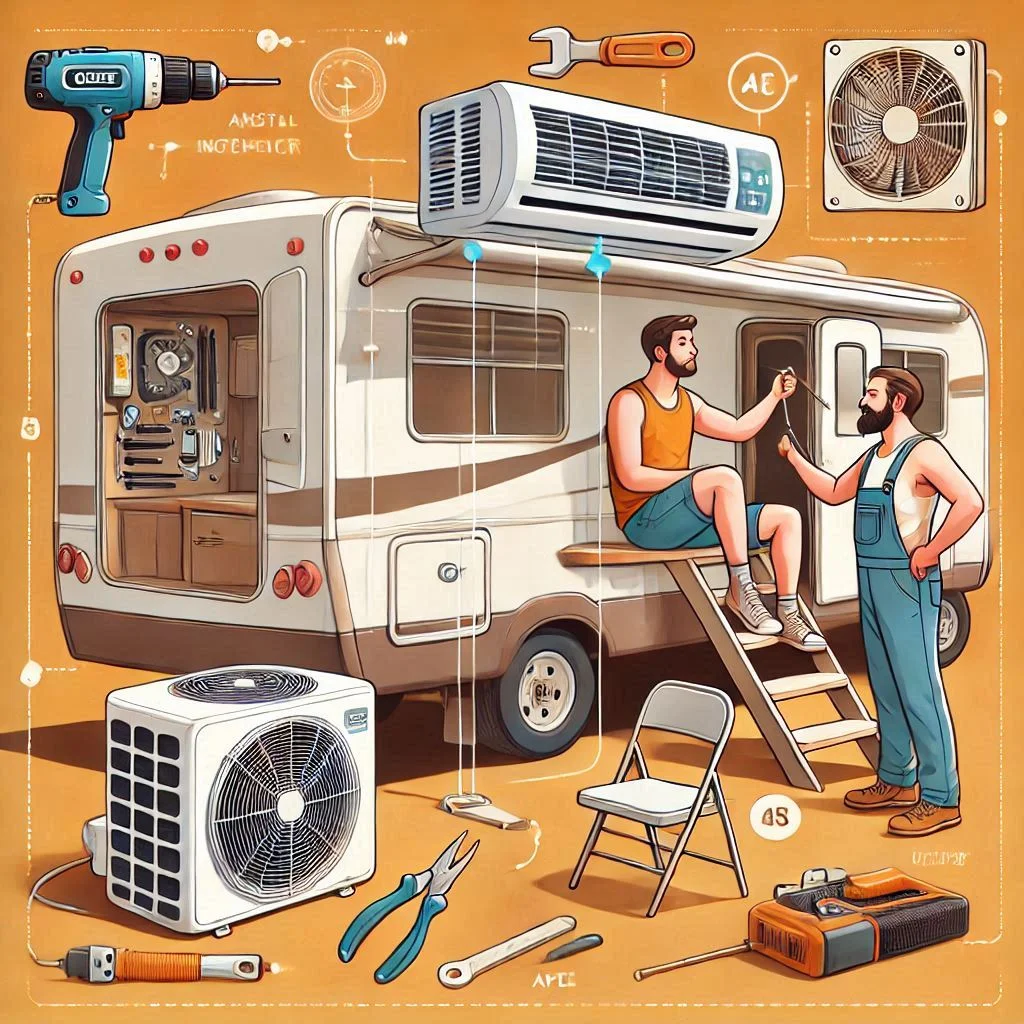
6. How often should I maintain my RV air conditioner?
Regular maintenance ensures that your RV air conditioner runs efficiently and lasts longer. You should perform maintenance at least twice a year:
- Spring: Before the summer season, clean the filters, coils, and check the refrigerant levels.
- Fall: After the season, inspect and clean the unit, and ensure it’s protected from the elements during storage.
Some maintenance tasks include:
- Cleaning the air filter and evaporator coil
- Checking the seals and seals for leaks
- Ensuring the unit’s fan and motor are working correctly
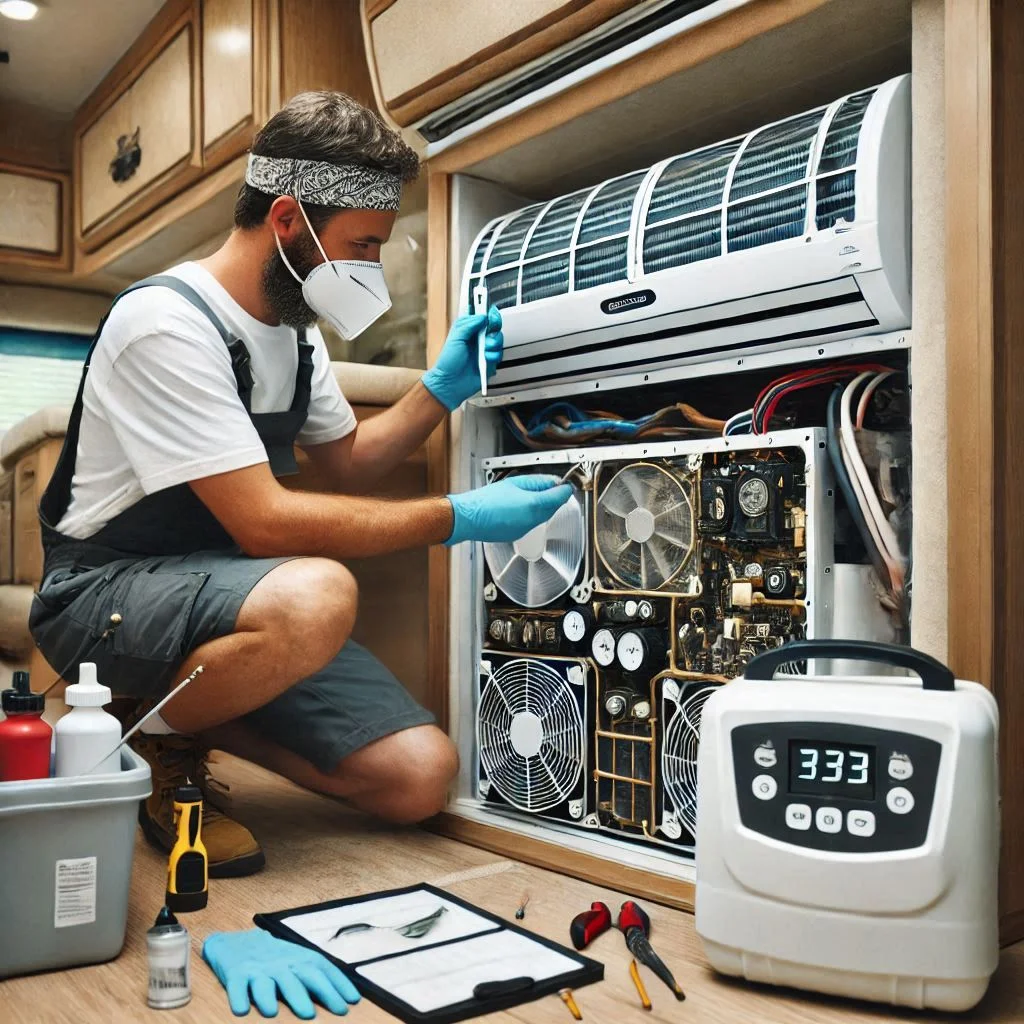
7. Can I run an RV air conditioner on battery power?
Yes, some inverter-style RV air conditioners are designed to run on battery power, though you need a strong battery bank or a solar setup. Most standard RV air conditioners, especially those with higher BTUs, require a generator or shore power to function.
For battery-powered AC operation:
- Consider units that have low power consumption, such as the Dometic Penguin II or Pioneer Mini-Split AC with inverter technology.
- If you plan to be off the grid, make sure to invest in solar panels and an appropriately sized battery to ensure continuous operation.
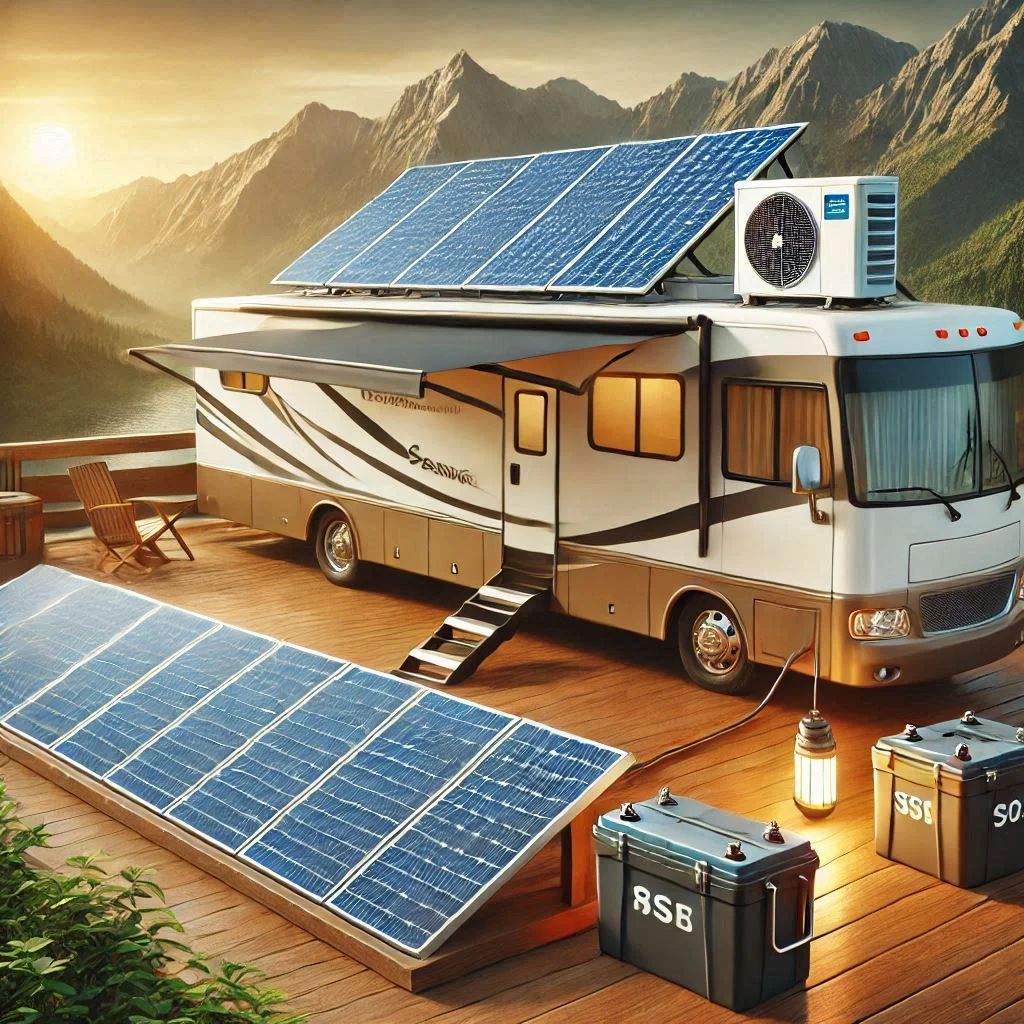
Key Takeaways:
- BTU Size: Choose the correct cooling capacity based on your RV size and climate.
- Energy Efficiency: Opt for models with inverter technology and Energy Star certification.
- Noise Levels: Quiet operation enhances comfort during travel or camping.
- Maintenance: Regular cleaning and inspections help prolong the life of your RV air conditioner.
- Self-Installation: Some models are DIY-friendly, while others may require professional help.
Conclusion:
Choosing the best RV air conditioner for your needs is crucial for ensuring a comfortable and enjoyable camping or road trip experience. By considering factors such as cooling capacity, energy efficiency, noise levels, and ease of installation, you can find the perfect unit to suit your RV size and lifestyle. Whether you prefer a rooftop model for its power or a portable unit for its flexibility, there are options available to meet every requirement. Don’t forget to keep up with regular maintenance to extend the life of your air conditioner and enhance its performance. With the right knowledge and careful selection, you’ll be able to enjoy cool, refreshing air on all your adventures. Happy travels, and stay cool!

